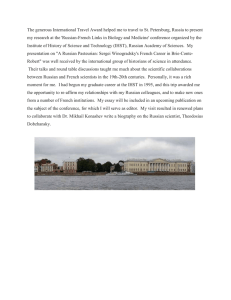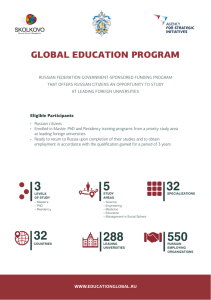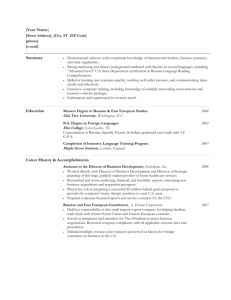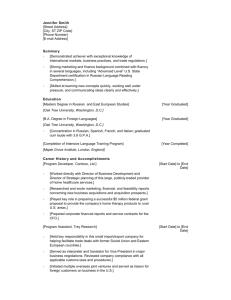Interlanguage Asymmetry as a Kind of Lexical Difficulties in the
advertisement
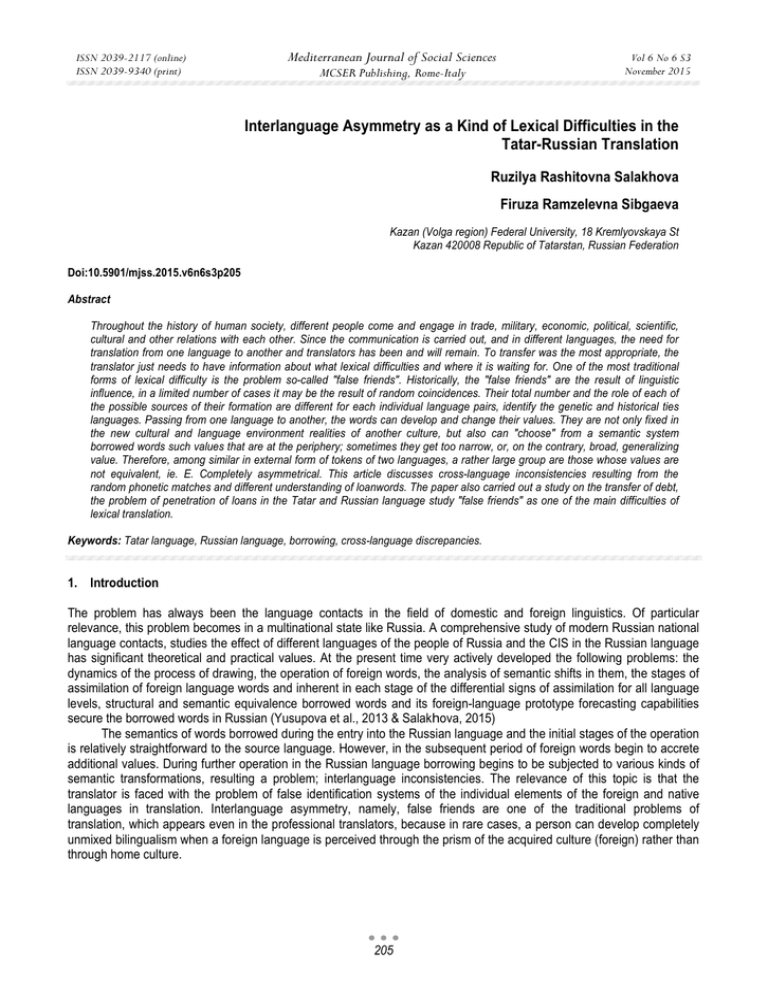
ISSN 2039-2117 (online) ISSN 2039-9340 (print) Mediterranean Journal of Social Sciences MCSER Publishing, Rome-Italy Vol 6 No 6 S3 November 2015 Interlanguage Asymmetry as a Kind of Lexical Difficulties in the Tatar-Russian Translation Ruzilya Rashitovna Salakhova Firuza Ramzelevna Sibgaeva Kazan (Volga region) Federal University, 18 Kremlyovskaya St Kazan 420008 Republic of Tatarstan, Russian Federation Doi:10.5901/mjss.2015.v6n6s3p205 Abstract Throughout the history of human society, different people come and engage in trade, military, economic, political, scientific, cultural and other relations with each other. Since the communication is carried out, and in different languages, the need for translation from one language to another and translators has been and will remain. To transfer was the most appropriate, the translator just needs to have information about what lexical difficulties and where it is waiting for. One of the most traditional forms of lexical difficulty is the problem so-called "false friends". Historically, the "false friends" are the result of linguistic influence, in a limited number of cases it may be the result of random coincidences. Their total number and the role of each of the possible sources of their formation are different for each individual language pairs, identify the genetic and historical ties languages. Passing from one language to another, the words can develop and change their values. They are not only fixed in the new cultural and language environment realities of another culture, but also can "choose" from a semantic system borrowed words such values that are at the periphery; sometimes they get too narrow, or, on the contrary, broad, generalizing value. Therefore, among similar in external form of tokens of two languages, a rather large group are those whose values are not equivalent, ie. E. Completely asymmetrical. This article discusses cross-language inconsistencies resulting from the random phonetic matches and different understanding of loanwords. The paper also carried out a study on the transfer of debt, the problem of penetration of loans in the Tatar and Russian language study "false friends" as one of the main difficulties of lexical translation. Keywords: Tatar language, Russian language, borrowing, cross-language discrepancies. 1. Introduction The problem has always been the language contacts in the field of domestic and foreign linguistics. Of particular relevance, this problem becomes in a multinational state like Russia. A comprehensive study of modern Russian national language contacts, studies the effect of different languages of the people of Russia and the CIS in the Russian language has significant theoretical and practical values. At the present time very actively developed the following problems: the dynamics of the process of drawing, the operation of foreign words, the analysis of semantic shifts in them, the stages of assimilation of foreign language words and inherent in each stage of the differential signs of assimilation for all language levels, structural and semantic equivalence borrowed words and its foreign-language prototype forecasting capabilities secure the borrowed words in Russian (Yusupova et al., 2013 & Salakԣova, 2015) The semantics of words borrowed during the entry into the Russian language and the initial stages of the operation is relatively straightforward to the source language. However, in the subsequent period of foreign words begin to accrete additional values. During further operation in the Russian language borrowing begins to be subjected to various kinds of semantic transformations, resulting a problem; interlanguage inconsistencies. The relevance of this topic is that the translator is faced with the problem of false identification systems of the individual elements of the foreign and native languages in translation. Interlanguage asymmetry, namely, false friends are one of the traditional problems of translation, which appears even in the professional translators, because in rare cases, a person can develop completely unmixed bilingualism when a foreign language is perceived through the prism of the acquired culture (foreign) rather than through home culture. 205 ISSN 2039-2117 (online) ISSN 2039-9340 (print) Mediterranean Journal of Social Sciences MCSER Publishing, Rome-Italy Vol 6 No 6 S3 November 2015 2. Methodology and Sources We used a range of methods and techniques, namely, descriptive method was used in the collection and systematization of materials on research; synchronous method of linguistic description of the material has been used in the description of loanwords in the Russian language; analytical method used in the processing of etymological (Chernyh, 1993 & Shan, 1994), Dictionary of Russian language (Ozhegov, 1993), the comparative historical method used to recover some of the history of the Tatar and Russian people to identify patterns of transformation of its language. 3. Main Part Among the most important circumstances affecting the development of a language, is the interaction of languages. This is particularly evident in cases where ethnic groups - the carriers of various languages - live in close and constant contact with each other. Ethnic groups living in or adjacent part of the overall political, economic, space, objectively forced to learn and accept each other's languages (Yusupova et al., 2013). The interaction between the different languages on the lexical level is an important page in the history of the vocabulary of each national language. The problem of lexical borrowing as a result of this interaction is one of the most important aspects in the development of the Russian language in different historical stages of its existence. Among the languages, and have helped shape the Russian language (Russian speach), occupies a special place the Tatar language. An important aspect of the study of the interaction of languages is figuring out what is the specificity of the Tatar borrowing a number of other levying of the Russian language. Western European and Turkic borrowings entered the Russian language in different contexts. For the process of borrowing from Western European languages characterized Doublet names, lexical redundancy. Tatar names of new loans being vital to the realities of everyday life – caftan (ɤɚɮɬɚɧ [kaftan]), yard (ɚɪɲɢɧ [arshin]), brick (ɤɪɢɩɢɱ [kirpich]), glass (ɫɬɚɤɚɧ [stakan]), dower chest (ɫɭɧɞɭɤ [sunduk]), stockings (ɱɭɥɤɢ [chulki]), iron (ɭɬɸɝ [utyug]) and others, and were for a long time been the only means of the nomination period and reflect lexical-semantic failure. The phenomenon of lexical redundancy touched Tatar borrowing only later, with the influx of zapadnoevropeizmov, which in some cases proved to be more viable: shoe (ɛɚɲɦɚɤ [bashmak]) – boots (ɛɨɬɢɧɨɤ [botinok]), pants (ɲɬɚɧɵ [shtany]) – trousers (ɛɪɸɤɢ [bryuki]), etc. For Western borrowing characteristic stylistic stability for the Tatar - lexical-semantic displacement. Some Tatar borrowing originally functioned as a neutral words in the future by going to the rank designations items obsolescent or obsolete, began to acquire stylistic coloring negatively estimated value (for example, hoodie (ɛɚɥɚɯɨɧ [balakhon]) - type of clothing: not the size of the wide clothes, chump (ɛɚɲɤɚ [bashka]) - fish head - bad, stupid head). The development of mobile values, resulting in the discharge passage Turkisms other thematic groups, also gave rise to variations Russian parallels emotional derogatory nature (for example, a donkey (ɢɲɚɤ [ishak]) - a stubborn, squab (ɬɸɮɹɤ [tyufyak]) - flaccid, one-track, etc.) (Muratov, 2000). Tatar vocabulary of the Russian language has its roots in the distant past. With the intensification of international contacts, trade, Tatars participate in various government projects in the XVI century begins to develop a bilingual situation, i.e. Russian and Tatars feel the need to know each other's language for the inevitable inter-ethnic communication. This occurred as the influence of the Russian language in the Tatar, and vice versa (Edihanov and Sibgaeva 2014). One of the main aspects of the study of Tatar borrowing in the Russian language is to establish the time of borrowing. For example, the word “ɛɚɲɥɵɤ” [bashlyk] celebrated as borrowing from Turkic languages not later of XIX century. However, under the form of “ɛɚɲɥɵɤ” should distinguish between two words, the split of the once common Turkic etymon, but at the time of borrowing is already representing two homonymous education. «Ȼɚɲɥɵɤ» - head and «ɛɚɲɥɵɤ» - hat, hood entered the Russian language in different periods, in different ways and have received various spheres of use and area of distribution. Initially, the likely «ɛɚɲɥɵɤ» was a borrowed word meaning "leader, rule, and boss". Time of occurrence of the word in this sense – XVI century. (Shanskij, 1994). The source language is Tatar, because this and preceding period was characterized by direct Russian-Tatar language contacts. Meaning – “special headdress” - the subject-specific Turkic languages of the Caucasian group. Consequently, this borrowing relates to a much later time - the first third of the XIX century as it was in this period, due to increased interest in Russian society to the Caucasus, to his way of life, customs, due svoynami that took place in the Caucasus, officially Business it, and then fiction gets the word as the name of the specific «ɛɚɲɥɵɤ» for Caucasian people headdress (Shanskij, 1994). Thus, without identifying the active period of the occurrence and the use of scientific etymologization impossible; without time correlation is impossible to address issues about the ways of penetration and the source 206 ISSN 2039-2117 (online) ISSN 2039-9340 (print) Mediterranean Journal of Social Sciences MCSER Publishing, Rome-Italy Vol 6 No 6 S3 November 2015 language or the intermediary. As noted above, the semantics of the borrowed word may be subject to various semantic transformations in the process of further functioning of the Russian language. Among the Tatar borrowing it is moved within different terminology systems and the scope of abstract concepts: «ɤɨɥɩɚɤ» - type of headgear, a butterfly net to catch fish; «ɛɚɲɦɚɤ» - type of shoe - technical device. Some of the words adaptation over time completely changed the semantic structure as compared to the etymon, and the original meaning of the borrowed word embossed secondary. For example, «ɛɚɡ» [baz] in Tatar means “cellar” in Russian – “yard”, “corral”. But some tokens, without losing its original values, began to acquire portable (Bazaar, horde, tent, etc.). Because of its ambiguity individual words can enter into different thematic groups. So, the word horde initially having a value of “encampment of nomadic peoples”, and then came to mean a “form of government”, “kind of public association” (The Golden Horde), later this word came figurative meaning “crowd, gathering of gang”; word «ɫɚɛɚɧ» [saban] within the meaning of the “big sled for transportation nets” can be seen in the thematic group “names of vehicles, denoted vocabulary” and the meaning of “two-wheeled plow”, “Mast Wood” - in thematic subgroups “Names household and professional tools and Appliances” (Gataullin, 1987). Based on the material of the etymological dictionary of the Russian language and involving other facts in the Russian language are the following types of inconsistencies within the Tatar borrowing: The first type of relations: in one, the word has a more general meaning than another language. For some words there was narrowing values compared to etymon. For example, the word «ɛɚɣɪɚɦ» [bairam] in the Tatar language means “festival”, in Russian - is used only to refer to the Muslim religious holiday. The second type of relationships: uniqueness in one language, ambiguity - in the other. Some tokens, without losing its original values, begin to acquire portable. There are the following models: For example, the name of the food (the product) - the name of the person: noodles (ɥɚɩɲɚ [lapsha]) “dough” – “weak-willed person”; the name of the food the name of a variety of items that are similar in appearance, similar in shape: noodles (ɥɚɩɲɚ [lapsha]) “dough as thin strips of dough” – “jerseys in fine elastic, easy stretch”, “trim, scraps of paper that ever stripes slice”; the name of the construction - the name of the person: beanpole (ɤɚɥɚɧɱɚ [kalancha]) “high observation tower on the building of the fire brigade” – “about a man of very high growth”; the animal names - the names of the person (often with a strong negative semantics) «ɨɫɟɥ» [osyol] – “donkey” - «ɨɫɟɥ» [osyol] – “an obstinate, foolish man”. The third type of relationship: a generic meaning in one language, the species - in the other. For example, ɤɚɜɭɧ [kavun] – “melon” - ɤɚɜɭɧ [kavun] – “watermelon”, ɚɪɛɭɡ [arbuz] “watermelon” - ɚɪɛɭɡ [arbuz] “pumpkin”, ɚɪɛɭɡ [arbuz] “melon”. The fourth type of relationship: a term in one language is not a term in another language. For many tokens indicating the Tatar language, included in the Russian language as the names of specific domestic realities, characterized by the acquisition of further terminological meanings. For example, ɫɟɪɶɝɚ [ser’ga] “title various fasteners, typically in the form of a ring or half-ring”; ɫɬɚɤɚɧ [stakan] “Names of the various special purpose, having the form of a hollow cylinder”, “shell, which encloses a charge of an artillery shell”, ɬɨɜɚɪ [tovar] “in the shoe business: Dedicated ready skin”. The fifth type of relationship: living, nearhaichnoe value in one language, an archaic (more or less) - in another. For example, the name of the construction ɱɟɪɞɚɤ (cherdak) (on Tatar language – ɱɚɪɥɚɤ [charlak]) - the name of the body: ɱɟɪɞɚɤ “head”; animal names - names of persons ɛɭɝɚɣ [bugai] “sire” – “on the big, strong man”, etc. (Salahova 2014). As can be seen from the examples, comparative aspect reveals general and specific Tatar borrowing in the Russian language, identify cross-language semantic relatedness in their functional significance in accordance with belonging to different stylistic levels. Thus, borrowing in this case Tatar speech, including the lexical system in a different language, it began to function in accordance with the general laws of development of the vocabulary of the language of the host, in this case, Russian, and thereby create lexical difficulties for inexperienced translators. No wonder they are called "false friends" (Salahova and Giniyatullina, 2013). Certain difficulties in translation and provide cross-language homonyms. All of these semantically more diverse cases have in common is the practical fact that the words associated and identifiable (because of the similarity in terms of expression) in two languages, in terms of content or use does not fully comply or not fully correspond to each other. Full mismatch plan content, ie the lack of common sense elements, most commonly found in random interlanguage homonyms, with no etymological connections. This category is considered by us Tatar-Russian interlingual homonyms. Here are some examples. The word «ɞɚɪ» [dar] in the Tatar language is used only in one sense: «ɞɚɪ» [dar] (n.) “Gallows” (n.) and in the Russian language has two meanings: 1) “a gift, donation” 2) “ability and talent”. Or, conversely, the Tatar word «ɛɭɪ» [bur] (n.), which has two meanings: 1) “chalk” 2) “thief” and the Russian word «ɛɭɪ» [bur] (n.) “Tool for drilling”. Interlingual homographs - words, writing the same, but different pronouncing by differences in word stress. These 207 ISSN 2039-2117 (online) ISSN 2039-9340 (print) Mediterranean Journal of Social Sciences MCSER Publishing, Rome-Italy Vol 6 No 6 S3 November 2015 are Tatar «ɛɚɛɚ» [baba] (n.) “revered clan, the founder of the settlement, the wise old man (elder), and the appropriate form of treatment to the honorable people or to their memory” and Russian «ɛɚɛɚ» [baba] (n.) “married farmer”, “simple, uneducated woman” or, for example, Tatar «ɹɪɵɣ» [yaryi] (particle) “Okay, fine” and Russian «ɹɪɵɣ» [yaryi] (adj.) “full of rage and anger”; Tatar «ɤɚɦɤɚ» [kamka] (n.) “Ladybug” and Russian «ɤɚɦɤɚ» [kamka] (n.) “Vintage silk diaper”; Tatar «ɤɚɪɚ» [kara] (adj.) “black” and Russian «ɤɚɪɚ» [kara] (n.) “Punishment, retribution”. A specific feature of Russian-Tatar interlingual homographs is that in the homonymous relations may come not only words having identical spelling but those tokens of Russian and Tatar languages, which does not differ in the place of word stress. Among interlanguage homonyms graphic type (homographs) constitute a special subgroup words coincide in Russian and Tatar writing, but differ in phonetic form. Such, for example, cross-language matching the type of Tatar «ɤɭɲ» [kush] (adj.) “double, twin” and Russian «ɤɭɲ» [kush] (n.) “Lot of money” or Tatar «ɢɥ» [il] (n.) “Country” and Russian «ɢɥ» [il] (n.) “Sticky sediment from mineral or organic matter”, Russian «ɞɵɦ» [dym] (n.) - “rising up dark clubs - volatile combustion with small particles of coal” and Tatar «ɞɵɦ» [dym] (n.) “Moisture, dampness”, also referred to as cross-language homography, for when the identity of graphic form like a token two languages have differences in the pronunciation of certain sounds. The extent of these differences is determined rather arbitrarily, mostly relying on the data of Russian and Tatar orthoepy (Salahova et al., 2013). As seen from the above examples, interlingual homonymy covers all that in the framework of the same order is identical to the level of formal language, but semantically different languages in contact. Thus, there is a rather unusual phenomenon - elements of different language systems, often completely independent of each other, come together into a kind of system of relations. The objective difficulties in translation and provide cross-language synonyms, which in turn are divided into total and relative. Cross-language full of synonyms to be considered correlated in one of the meanings of the two (or more) languages, which express the same concept and do not differ from each other emotionally expressive, stylistic or any other kind of constant significant information. The relative cross-language synonyms, are an example of interlanguage asymmetry, since the similarity of the conceptual content of the compared words of emotional and stylistic characteristics are not the same. It follows that any word is matched against the value and complete, and relative synonymous depending on with which the corresponding word number is compared synonymous. For example, the idioms meaning “to cheat” – «ɹɥɝɚɧɥɚɭ» [yalganlau], «ɚɥɞɚɥɚɭ» [aldalau] (Tatar), are examples of the full cross-language synonyms «tιti kίrsιtep yλrtί» (Tatar), «ɜɨɞɢɬɶ ɡɚ ɧɨɫ» (Russian); «Ike yλzle ɛɭɥɭ» (Tatar) – «ɤɪɢɜɢɬɶ ɞɭɲɨɣ» (Russian); «ɛɨɪɱɚɤ ɚɬɭ» (Tatar) – «ɨɬɥɢɜɚɬɶ ɩɭɥɢ» (Russian); «kίzgι tλten Χibιrί» (Tatar) – «ɧɚɩɭɫɤɚɬɶ ɬɭɦɚɧɵ» (Rusian); «ɚɝɚɱ ɚɬɤɚ ɚɬɥɚɧɞɵɪɭ» (Tatar) – «ɨɛɜɨɞɢɬɶ ɜɨɤɪɭɝ ɩɚɥɶɰɚ» (Russian); «ɤίɡɝι ɤɨɦ ɫɢɛί» (Tatar) – «ɩɭɫɤɚɬɶ ɩɵɥɶ ɜ ɝɥɚɡɚ» (Russian) (Sibgaeva and Salahova, 2014; Sibgaeva, 2014 & Sibgaeva, 2015). Thus, the problem of cross-language synonyms when translating is reduced, as a rule, to the choice of a number of lexical equivalents most appropriate - one that is most appropriate semantics, pragmatics and style of the original. This requires the faithful interpreter of the isolation in the text of its semantic dominants. The objective difficulties of literary translation are thus associated with the subjective - primarily with the creative interpretation of the original text translator. 4. Ɍonsequence In conclusion, it should be noted that the category of "false friends" reflects a fairly complex and multifaceted phenomenon of interlanguage asymmetry. Even the presence of bilingual dictionaries are not always able to help the translator to avoid false steps. The similarity of shape and the idea that language universals can create special psychological climate in which the translator can not even look in the dictionary to verify the validity of the choice of the equivalent. Therefore, the phenomenon of interlanguage asymmetry and constitutes an integral part of the theory of translation equivalence. Translator involuntarily recalls etymologically identical Tatar word and overlooks the fact that its value and use does not coincide with the Russian. Partial divergence values may be in practice more dangerous than one might think: false semantic proximity leads to mutual replacement of these offensive words when translating from one language to another (Garbovsky, 2007). It should be noted that the incomplete lexical parallels are often difficult not only for foreign language learners, but also for those who speak foreign languages at a high enough level. Even they often underestimate the impact of crosslanguage interference and carry logic-substantive communication from one language to another (Fatkhullova et al., 2013). During the study of similar sounding words of Tatar and Russian languages identified linguistic criteria for defining this group of words like interlanguage homonyms. Description Tatar and Russian language on a comparable basis, 208 ISSN 2039-2117 (online) ISSN 2039-9340 (print) Mediterranean Journal of Social Sciences MCSER Publishing, Rome-Italy Vol 6 No 6 S3 November 2015 highlighting similarities and differences within the interlanguage homonyms belonging to the category of loanwords, promotes better understanding of the phenomena of the Tatar and Russian languages, is the basis for determining the place of interlingual homonyms in the circle of related phenomena of two different systems of languages. Interlingual homonymy is an open lexical subsystems having internal classification in the languages of different. It is based on categorical morphological, word formation and semantic features that indicate the importance of this phenomenon and the need for its further theoretical understanding. One of the key aspects is the study of borrowings in terms of identifying their paradigmatic and syntagmatic relations with the native language vocabulary. It is necessary to follow trends in the use Turkisms synonymous in the ranks and the establishment of semantic compatibility of a lexical compatibility in each particular historical period analyzed the functioning of words (Salahova, 2014). In operation Tatar borrowing, it is succumbing to the common language trends semantic transformation, becoming portable values. An interesting aspect of the study of Tatar borrowing in terms of their penetration within different terminology systems Language receptor. Ordering of varieties of figurative meanings revealed the main types Semnyi education. All these types, evidence of the systematic semantic changes taking place and confirming the position that the semantics as well as other levels of the language, systematically organized, is reflected in this article. 5. Conclusions Every day, people faced with many foreign languages - on goods, borrowing language, interpersonal contacts. On this basis there are new, unknown hitherto systemic relationship between language systems, which finds its expression in the considered topic interlanguage asymmetry. There is confusion - and offset - the values in the practice of the language person. At first glance it may seem that "false friends" can be administered, only misleading people who start learning the language, and their poor knowledge. In fact, the opposite is the case: the bulk of "false friends" it is dangerous for people with confidence and almost satisfactorily using the language, though not unmixed reaching adequate degree of bilingualism and thus admitting the false identification of the individual system components of the foreign and native languages. To solve this problem dictionaries are the so-called "false friends," words whose use causes any problems, a detailed description of the meaning of such words in both languages, and the rules for their use. Although the issue of "false friends" attracts the attention of many experts in translating and teaching foreign (and even second) language, detailed examination of this category of words for the great majority of languages available. During the study interlanguage asymmetry in the Tatar-Russian translation, to find out that the problem is also poorly known. Language material was collected from a bilingual Russian-Tatar and Tatar-Russian dictionaries, and dictionaries have been used both languages and etymological dictionary of the Russian language. However, the chronology and the etymology of words of Tatar origin in the corresponding dictionaries to date does not take account semantic chronological, historical and geographical factors. Thus, for the correct translation from the Tatar into Russian, you must create dictionaries "false friends", this kind of dictionaries combines the peculiarity that they are not a substitute - for the considered words - ordinary bilingual dictionaries, and is a collection of unique and often very valuable, but sometimes random comments. Such comments are aimed at preventing errors when using a foreign language, sometimes - to improve the quality of translations and even just to improve the culture of the native language. References Garbovsky, N. K. (2007). Translation theory : Textbook (2nd ed.). M.: Izd. University Press. Gataullin, R. A. (1987). Turkisms Russian names in buildings and construction business. (Master’s thesis, Baku). Edikhanov, I. Zh., & Sibgaeva, F. R. (2014). Peculiarities of translation of the parables of didactic texts of Tatar writer-enlightener K. Nasyri into Russian language. Journal of Language and Literature (329-332). Karabulatova, I. S., Polivara, Z. V., & Zamaletdinov, R. R. (2013). Ethno-linguistic peculiarities of semantic perception of language competence of tatar bilingual children. World Applied Sciences Journal, 27(13 A), 141-145. doi:10.5829/idosi.wasj.2013.27.elelc. 29 Muratov, G. R. (2000). On the thematic groups of the Tatar language in the etymological dictionary of the Russian language. Kazan. Ozhegov, S. I. (1993). Dictionary of Russian language. Moscow. Salakhova, R. R, Gainutdinova, G.R and Muharlyamova, G. N. (2013). Tatar - Russian cross-language as a kind of lexical homonyms translation difficulties. Philology. Theory and practice (159 – 162). Salakhova, R. R, & Giniyatullina, L.M. (2013) "False friends" in the Tatar- Russian and Russian -Tatar translations. Philology. Theory and practice (85-87). 209 ISSN 2039-2117 (online) ISSN 2039-9340 (print) Mediterranean Journal of Social Sciences MCSER Publishing, Rome-Italy Vol 6 No 6 S3 November 2015 Salakhova, R. R. (2014). Translation mismatch Tatar borrowing in Russian. Philology . Theory and practice, 222 (188-190). Salakhova, R. R. (2015). Onomatopoetic vocabulary in Tatar language and ways of its Russian translation (based on the novel by Absalyamova "White flowers"). Philology. Theory and practice (159-162). Sibgaeva, F. R., & Salakhova, R. R. (2014). Space in a world view of poetic phraseology of the Tatar language. Journal of Language and Literature (271-274) doi: 10.7813/jll.2014/5-3/46. Sibgaeva, F. R. (2014). Lexis connected with person in tatar language. International multidisciplinary scientific conferences on Social sciences and arts Sgem (126-131). Sibgaeva, F. R. (2015). Phraseological units as the way of tatar language person representation. Journal of Language and Literature. (101-103). Fatkhullova, K. S., Zamaletdinov, R. R., & Yusupova A. Sh. (2013). Information-Communicative Devices for Tatar Language Teaching. World Applied Sciences Journal,( 103-107). Yusupova, A. S., Denmukhametova, I. N., Nabiullina, G. A., & Mugtasimova, G. R. (2013). Features of the language of tatars living in china. Middle East Journal of Scientific Research, 17(2), 168-172. doi:10.5829/idosi.mejsr.2013.17.02.12181 Yusupova, A. S. (2014). Tatar language dictionaries of XIX century as a unified historical and cultural phenomenon. World Applied Sciences Journal, 30(2), 186-190. doi:10.5829/idosi.wasj.2014.30.02.14003 Chernykh, P.Y. (1999). Historical and etymological dictionary of modern Russian. Moscow. Shan, N. M., & Bobrova, T. Ⱥ. (1994). Etymological dictionary of the Russian language. Moscow: Proserpine. 210

